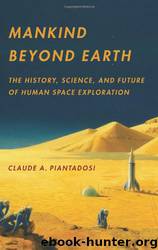Mankind Beyond Earth by Claude A. Piantadosi

Author:Claude A. Piantadosi [Piantadosi, Claude A.]
Language: eng
Format: epub
Tags: Science, Physics, Astrophysics, Space Science, Technology & Engineering, Aeronautics & Astronautics, vl-nfspace
ISBN: 9780231162425
Google: 5h0Jd9OuC8IC
Amazon: 0231162421
Publisher: Columbia University Press
Published: 2013-01-02T00:00:00+00:00
FIGURE 6.3. THE MASS BALANCE OF THE HUMAN BODY.
Daily requirements are based on an average metabolic rate for a 70 kg man in a thermally neutral environment (140 watts). Losses are apportioned into liquid and solid components, except for CO2, which is a gas at body temperature. Hygiene water is for bathing and for washing clothing and other items. Solids can be recycled along with waste water.
Finally, let’s illustrate how much “junk” a crew on a voyage to Mars would generate if spent resources are recycled at an efficiency of 50 percent. On the positive side, the ship would carry only half the usual amount of supplies on the mission. In other words, a round trip requires exactly the same amount of O2 as a one-way trip where there is no recycling. Of course, there’s no such thing as a free lunch: more energy is needed, and the crew must still dispose of half of what it uses. The important exception is water, because of its more efficient recycling.
I once thought of waste disposal in space as just so much rubbish, only later recognizing how little trash is appreciated until the garbage man goes on strike. The cities of New York and Naples are notorious for this, but the Mir station was once euphemistically known as the “pigpen” in space. When resupply missions to the ISS were interrupted for two years after the Columbia mishap, garbage became a major issue. In 2004, Space.com even ran a headline, “There Is No Space on the Space Station.”
It is not necessary to go into great detail on garbage disposal; a simple example will suffice. In 2006, a NASA committee on waste processing and resource recovery estimated that a crew of six en route to Mars would produce about 10.5 kilograms (23 lbs) of organic waste each day. A year would thus produce nearly four metric tons of biodegradable waste. The question is what to do with it.
The idea of returning tons of waste to Earth from Mars, some of it three years old, would be unpleasant for the crew, who would prefer simply to shoot it into space. On Mars, the expedient option, which would be to compact it and fill a crater up with it, is politically incorrect, but that is safer than trying to take off with eighteen months of trash. Trash dumps are not allowed at the South Pole, and they would be offensive on Mars too, but practicality may supersede sensibility. Technically advanced options like waste reconditioning for fertilizer or bioreactor fuel are expensive.
The idea of producing power biologically—so-called biopower—has been around a long time, but it is in its infancy for space exploration. Mature options include devices that convert kinetic energy (motion) into electrical current, like lamps powered by pedaling your bike or cell phones charged by cranking a handle. An interesting new prospect, microbial fuel cells, relies on bacteria that release electrons during metabolism. Both types of systems, as well as some that convert cosmic radiation into electricity, are on the drawing boards.
Download
This site does not store any files on its server. We only index and link to content provided by other sites. Please contact the content providers to delete copyright contents if any and email us, we'll remove relevant links or contents immediately.
| Automotive | Engineering |
| Transportation |
Whiskies Galore by Ian Buxton(41941)
Introduction to Aircraft Design (Cambridge Aerospace Series) by John P. Fielding(33095)
Small Unmanned Fixed-wing Aircraft Design by Andrew J. Keane Andras Sobester James P. Scanlan & András Sóbester & James P. Scanlan(32767)
Craft Beer for the Homebrewer by Michael Agnew(18200)
Turbulence by E. J. Noyes(7983)
The Complete Stick Figure Physics Tutorials by Allen Sarah(7339)
Kaplan MCAT General Chemistry Review by Kaplan(6903)
The Thirst by Nesbo Jo(6882)
Bad Blood by John Carreyrou(6584)
Modelling of Convective Heat and Mass Transfer in Rotating Flows by Igor V. Shevchuk(6408)
Learning SQL by Alan Beaulieu(6239)
Weapons of Math Destruction by Cathy O'Neil(6220)
Man-made Catastrophes and Risk Information Concealment by Dmitry Chernov & Didier Sornette(5958)
Digital Minimalism by Cal Newport;(5707)
Life 3.0: Being Human in the Age of Artificial Intelligence by Tegmark Max(5520)
iGen by Jean M. Twenge(5387)
Secrets of Antigravity Propulsion: Tesla, UFOs, and Classified Aerospace Technology by Ph.D. Paul A. Laviolette(5336)
Design of Trajectory Optimization Approach for Space Maneuver Vehicle Skip Entry Problems by Runqi Chai & Al Savvaris & Antonios Tsourdos & Senchun Chai(5040)
Pale Blue Dot by Carl Sagan(4960)
